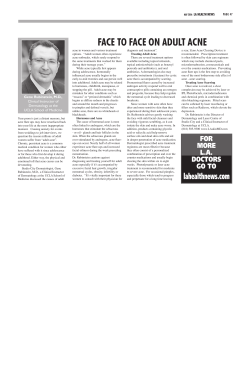
a ult d Acne
adult Acne What is acne? Acne is the most common skincare problem seen by doctors. It occurs when hair follicles become clogged by a combination of an oily substance (produced by the skin) called sebum, dirt, and dead skin cells. Often, bacteria called Propionibacterium acnes (P. acnes), can be present too, which can contribute to the redness, swelling and pus that can accompany lesions. The visible result is acne, which is the term used to describe blackheads, whiteheads, pimples, and cysts. Acne usually appears on the face and neck but it can include shoulders, back, and arms. About adult acne Acne that starts during adolescence or teens can continue into adulthood in a milder or more severe form. Meanwhile, just because you made it through your teens without a blemish doesn’t always mean you’re in the clear yet. Acne can begin in adulthood too, and three quarters of adult acne occurs in women. Sexual hormone fluctuations are usually responsible, which is why women may suffer “cyclical acne” that shows up before their menstrual periods, or acne flare-ups during pregnancy or menopause. Stages of acne normal hair follicle open comedo closed comedo (blackhead) (whitehead) papule pustule Dealing with acne scars Even mild acne can produce scarring, although the more severe acne (cystic) is associated more strongly with the risk of scarring. It’s hard to tell, though, who will develop scarring and how severe it will be. Scars are the result of injury to the skin, and what you see is the loss of skin tissue or the build-up of excess skin tissue. You can basically get one of two types of scarring: depressed (pitted) scars or elevated (thickened) scars. Avoid scarring Speak to your family doctor or dermatologist about what treatment is best for you. BABIES CAN GET ACNE TOO! Acne can even show up as early as birth, but this form is more specifically called acne neonatorum or simply “baby acne”. It is a common skin condition that affects about 20% of all newborns. Mainly affecting the cheeks and nose, lesions appear as small, red papules. Baby acne usually appears 2 weeks after birth and lasts from a few weeks to a few months. It can flare up and become more irritated when skin comes into contact with saliva, milk, some fabrics, or when a baby is too hot. This information sheet has been produced with the assistance of an unrestricted educational grant from: WAYS TO REDUCE ACNE SCARRING Prevention is the best treatment for acne scars, which includes treating acne early and controlling it to prevent new lesions from forming. There are several ways to treat scars if you do develop them: Tretinoin creams and gels can be used as a nonsurgical way to treat superficial scarring (as opposed to deep or elevated scarring). They help with new collagen production, basically assisting skin to build new, unscarred tissue. Chemical or alphahydroxy acid (AHA) peels help to even out skin tone and can smooth out slight imperfections. Microdermabrasion, also known as a “power peel”, is recommended for superficial mild acne scars. It involves a 10-20 minute treatment that removes the uppermost damaged layers of skin. Injectable fillers include materials such as collagen and hyaluronic acid, which are injected below the skin’s surface to plump up pitted areas from rolling scars. Laser skin resurfacing removes a damaged surface layer, which helps to smooth out the appearance of deeper scars. It also encourages new collagen formation in the skin.
© Copyright 2025





















